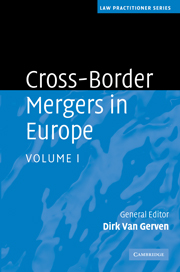18 - Norway
from Part III - Application in the EEA Member States
Published online by Cambridge University Press: 03 May 2010
Summary
Introduction
1. Norway is not a member of the European Union, but a party to the EEA Agreement. The Cross-border Merger Directive was implemented in the EEA Agreement on 22 September 2006, and the Norwegian Parliament approved the implementation on 20 March 2007.
The incorporation of the Cross-border Merger Directive into Norwegian law was made through the adoption of the Act of 21 December 2007 no 129 on amendments to the Act on Private Limited Liability Companies, the Act on Public Limited Liability Companies and certain other acts (the ‘Amendment Act’) and the adoption of the regulation regarding employee representation rights on 9 January 2008 (the ‘Employee Regulation’).
The Amendment Act inserted a new Chapter 13 VII with the heading ‘Cross-border Merger’ and a new Chapter 14 III, entitled ‘Cross-border Division’ into the Act of 13 June 1997 no 44 on Private Limited Liability Companies and the Act of 13 June 1997 no 45 on Public Limited Liability Companies (the latter act is hereinafter referred to as the ‘PLLC Act’). The law technique applied in the Amendment Act was to implement the Cross-border Merger Directive in full text in Chapter 13 VII of the PLLC Act with respect to public limited liability companies, and then extend the application of these rules to private limited liability companies through a cross-reference provision in Article 13-25 of the Act on Private Limited Liability Companies referring to the PLLC Act.
- Type
- Chapter
- Information
- Cross-Border Mergers in Europe , pp. 305 - 324Publisher: Cambridge University PressPrint publication year: 2010



